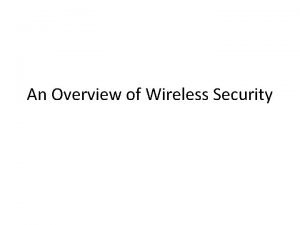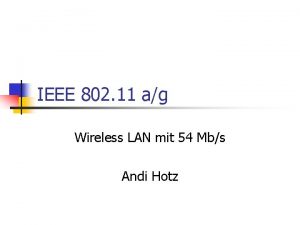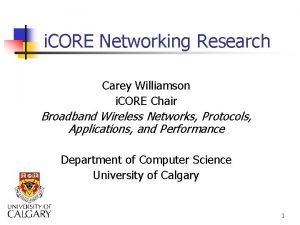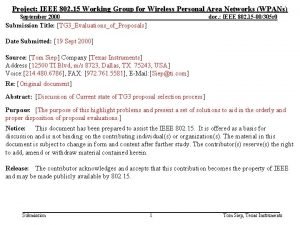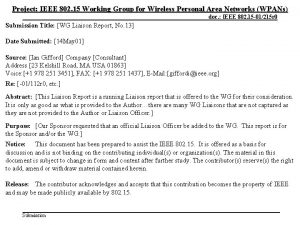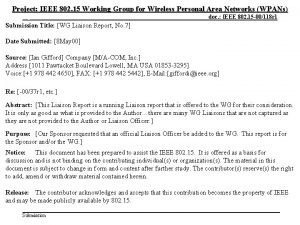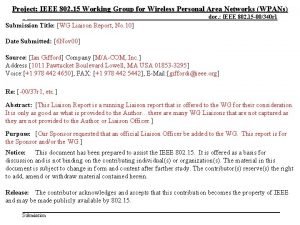Project IEEE 802 15 Working Group for Wireless






- Slides: 6

Project: IEEE 802. 15 Working Group for Wireless Personal Area Networks (WPANs) January 2004 doc. : IEEE 802. 15 -04/0051 r 2 Submission Title: [TG 3 a Requirements Supporting a Common Base Mode ] Date Submitted: [19 Feb 2004] Source: [John Barr] Company [Motorola] Address [1303 E. Golf Road, Schuamburg, IL 60196] Voice: [+1 847 576 -8706], FAX: [+1 847 576 -6758], E-Mail: [John. Barr@Motorola. com] Re: [15 -04 -0051 -02 -003 a TG 3 a Compromise Proposal] Abstract: [Requirements Supporting a Common Base Mode for TG 3 a PHY] Purpose: [Rationale for proceeding with a compromise for TG 3 a PHY selection. . ] Notice: This document has been prepared to assist the IEEE 802. 15. It is offered as a basis for discussion and is not binding on the contributing individual(s) or organization(s). The material in this document is subject to change in form and content after further study. The contributor(s) reserve(s) the right to add, amend or withdraw material contained herein. Release: The contributor acknowledges and accepts that this contribution becomes the property of IEEE and may be made publicly available by 802. 15. Submission 1 Dr. John R. Barr, Motorola

January 2004 doc. : IEEE 802. 15 -04/0051 r 2 802. 15. 3 MAC Allows Multiple PHYs • Beacon and PNC commands sent using common base mode • Peer to peer communications scheduled at distinct times in a super frame: – Peer devices determine which optional PHY rate will be used in time slot (11, 22, 33, 44, 55) – PNC only assigns time slot for peer to peer communications. – Devices select common rate according to availability and channel conditions – Allows addition of new PHY modes without requiring every device to be upgraded at the same time. Submission 2 Dr. John R. Barr, Motorola

January 2004 doc. : IEEE 802. 15 -04/0051 r 2 Variable UWB PHY Requirements • A large range of use cases have been presented for the TG 3 a Alternate PHY: – Very high rate, isochronous transport of multimedia content (HDTV, Home Theater) between powered and portable devices. – Transfer of large amounts of data (video, image, MP 3) between portable devices and PCs/media servers. – Transfer of individual items between like devices (e. g. , exchange images between group capture camera and those cameras carried by the group in the image) – Interaction of portable devices sharing a local experience (multi-player gaming) • It is hard for a single PHY implementation to satisfy all of these use cases well: – High data rate short range transfers vs wireless home theater connectivity – A PHY selection that leaves openings for more efficient PHY choices will always be under attack by more appropriate PHYs Submission 3 Dr. John R. Barr, Motorola

January 2004 doc. : IEEE 802. 15 -04/0051 r 2 Long Term Success • 802. 15. 3/3 a defines an UWB solution that is used in large number and variety of devices. • As technology improves, any 802. 15. 3/3 a device can coexist and interoperate with all of the current (legacy) and future devices. • An ecosystem for WPAN technology evolves because of the ubiquity of the 802. 15. 3/3 a standard in devices (i. e. , Wi. Fi) • 802. 15. 3/3 a common base mode obtains regulatory approval world wide and one or more optional modes approved for use in a region are enabled by the PNC. Submission 4 Dr. John R. Barr, Motorola

January 2004 doc. : IEEE 802. 15 -04/0051 r 2 Core Ubiquity Requirements • All devices must have a common PHY mode that is used for PNC operation and interoperability between devices until common optional PHY modes can be determined. • All common required features must be as simple as possible to ensure efficient implementation of low end devices. • Dependence on the common PHY mode must be minimized to allow high-performance devices to get the most performance out of the available channel. • It must be possible for separate environments to co-exist within the same channel (child/neighbor piconet). Submission 5 Dr. John R. Barr, Motorola

January 2004 doc. : IEEE 802. 15 -04/0051 r 2 Derived Features • Very low cost common PHY mode suitable for multiple UWB modulation technologies. • The beacon must be sent using the common PHY mode at some regular interval (e. g. every 100 m. S or more) • The PNC shall be able to designate a different PHY mode for beacons and commands based on the capability of devices in the piconet and channel characteristics. • Devices can select the most appropriate PHY mode for communications between any peer device independent of the capabilities of the PNC or other devices in the piconet. Submission 6 Dr. John R. Barr, Motorola


